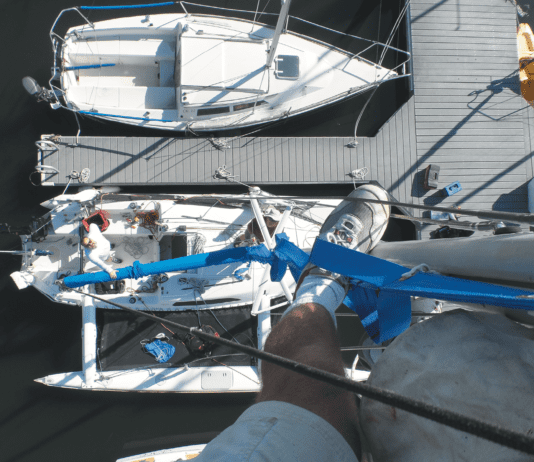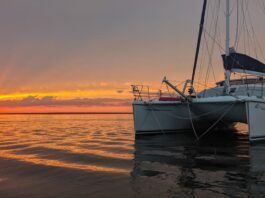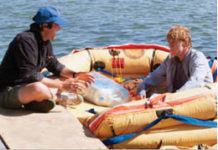How to Sail Around the World Tip #4
Excerpted from How to Sail Around the World
After trying many sails and lots of sail-handling schemes, I have learned which sails to buy and how to use them quickly and efficiently. Ive discovered nothing new or startling, but my wife and I have been able to make our sailing easier and keep the yacht going better by the use of slab reefs, roller furling, deck bags, and furling socks.
Ive tried to sort all this into a reasonable progression - a sort of master plan - so that in the normal wind range (say 0-30 knots), our transition from one sail to another is reasonable and orderly. We want to make the maximum use of each sail for its wind range and to avoid overlaps. We consider the weight of all the sails, their cost, and the room they take up when stored. We know that the seven sails in our inventory (plus two spares for a world-ranging yacht) include some compromises but ensure the following:
- Good performance in strong and light airs, both in and off the wind.
- Ease in dealing with and changing sails, with a minimum of hazardous foredeck work. In particular, theres no changing down from a large genoa rigged on a forestay furling system when it breezes up.
- Reasonable spares in case of emergency.
We are learning all the time, and when we find something thats better, we switch to it. Our golden rule is the simpler the better.
Our yacht Whisper is a 35-foot masthead sloop. She has a sail area of 640 square feet, which includes a 100 percent foretriangle of 359 square feet. Like many International Offshore Rule (IOR) boats designed twenty years ago, the boat has a tall and skinny high-aspect mainsail (of 281 sq. ft. for us). The top of her mast is 53 feet above the water. Her designed displacement is 14,148 pounds. My guess is that with all her cruising gear on board (anchors, tools, fastenings, sails, clothing, charts, books, dingies, spare parts, food, liquids, etc.), she would hit the bathroom scales at a real-world weight of 18,000 pounds.
Whispers sail inventory consists of seven sails, plus two spares. The sails: mainsail, jib, staysail, storm jib, trysail, gennaker and spinnaker. The spares are an old mainsail and jib.
For more cruising lessons, advice and stories, purchase Hal Roths How to Sail Around the World from Practical Sailor.
Nigel Calders Cruising Handbook tip #1
In his book, Nigel Calders Cruising Handbook, Calder takes a detailed look at both the necessary and desirable features of deck hardware. Heres some of his advice:
Electrical cabling is sometimes run loosely inside masts. It rattles and bangs annoyingly, and may eventually chafe through (at which point it may cause severe stray current erosion). It should always be installed in a plastic conduit. Conduit can be retroactively installed on masts by laying the mast down horizontally, removing the existing cables, building up the necessary length of conduit outside the mast, putting a generous bead of silicone rubber or polyurethane adhesive on one side of the conduit, sliding the conduit into place with the silicone or polyurethane facing away from the mast wall (so that it does not get rubbed off), and then rolling the conduit over so that the silicon or polyurethane ends up between the mast wall and conduit, gluing the conduit in place. The conduit is then drilled for the necessary exit holes (e.g., spreader light), after which fishing wires are used to pull through fishing lines, which are then used to pull cables back into place.
For more information and advice on what to look for in and on a cruising boat, purchase Nigel Calders Cruising Handbook from Practical Sailor.
Calder’s Cruising Handbook Tip #2
In his book, Nigel Calders Cruising Handbook, Calder takes a detailed look at both the necessary and desirable features of deck hardware. Heres some of his advice:
All cleats on the mast (and many elsewhere) need to be large enough to take not only the two turns needed to cleat off a line, but also (at least on the top end of the cleat) to then comfortably hold another turn that is used to stow the line (as a general rule, the length of a cleat should be at least sixteen times the diameter of the line to be stowed on it). Too often, the horns are barely long enough; in rough weather, the stowed line comes loose and streams back down a side deck or overboard.
For more information and advice on what to look for in and on a boat for your cruising, purchase Nigel Calders Cruising Handbook from Practical Sailor.
Calder’s Cruising Handbook Tip #3
In his book, Nigel Calders Cruising Handbook, Calder takes a detailed look at the types of sailboats to consider for cruising. Here are some of his thoughts:
Center or Aft Cockpit
The most basic question to be settled is whether to have a center or aft cockpit. Center cockpits have grown in popularity over the past couple of decades, particularly since the popularization of the deck-saloon concept by Oyster Yachts. The center cockpit puts the cockpit to the longitudinal center of motion of the boat and closest to the mast, making it easier to run the lines to the cockpit and to go forward to work the sails if necessary. There is almost always much better visibility forward.
When combined with the deck-saloon concept, the raised sole beneath the deck saloon provides volume for the engine, batteries, tankage, and an AC generator, keeping all this weight low in the boat and close to the longitudinal center of gravity (which reduces pitching in head seas). Above all, the center cockpit enables a substantial aft cabin to be put on a boat, transforming accommodations.
An aft cabin does not work too well until a boat is large enough to provide reasonable inside access to it down the underside of the cockpit coaming. If this is not possible, the aft cabin will have a forward-facing companionway, which will be exposed to the weather. It will be necessary to transit the cockpit to enter and exit the cabin. If the aft cabins companionway hatch is opened for light or ventilation, there is no privacy for the cabin. With or without a companionway, aft cabins typically suffer from a lack of ventilation.
The attempt to provide an aft cabin with inside access on a smaller boat leads to excessive freeboard with a high, shallow cockpit that is uncomfortable and unseaworthy, and a raised house on an aft cabin that makes it difficult to work on a deck in rough weather. Inevitably, there is always someone who tries to push the design envelope too far.
Hard on the wind, the center cockpit - being that much farther forward than an aft cockpit - tends to catch a lot more spray. Some are notoriously wet. A center cockpit is invariably higher than an aft cockpit, which may put the heads of taller people within range of the boom - a potentially dangerous situation. On many boats, the cockpit sole is close to the height of the lifelines, with the coamings well above the lifelines. In rough weather, there is a significantly greater chance of getting pitched overboard when entering or leaving the cockpit than on an aft-cockpit boat. The center cockpit complicates steering and makes it difficult to rig the control lines for a wind and vane. A center cockpit often has somewhat limited cockpit stowage. It also precludes dinghy stowage between the cockpit and the mast (which is often the optimum location on an aft-cockpit boat).
For more detailed advice on what to look for in and on a boat for your cruising, purchase Nigel Calders Cruising Handbook from Practical Sailor.
Calder’s Cruising Handbook Tip #4
In his book, Nigel Calders Cruising Handbook, Calder takes a detailed look at both the necessary and desirable features of an offshore cruising boat. Heres some of his advice:
Dodgers and Biminis
A dodger (spray hood) has to be high on the priority list of any cruising sailor, with a cockpit bimini not far behind. Together, they make a tremendous contribution to onboard comfort, particularly when watch-keeping in foul weather or sailing under a tropical sun. To get the most out of them, they have to be carefully thought out, including the following features:
- standing headroom in the cockpit
- easy entry and exit from the cockpit, including strategically placed grab bars (rarely fitted), and perhaps zippered over-head sections between the dodger and bimini to open up the point of entry/exit
- sufficient strength to withstand people swinging on and lurching into the support structures, and to stand up to gale-force winds and the impact of wave crests coming aboard
- the framework, when erected or folded down, to be located so that it does not interfere with the working of the boat (e.g. operating rope clutches on the cabin top and cranking winches) and to have some means of tying it down in the face of boarding waves
- a dodger coaming (to which the dodger attaches) that stops water surging across the deck before it gets under the dodger
- both the dodger and the bimini to be designed and cambered so that rain water is shed outside the cockpit, not inside it
- both the dodger and the bimini to be stretched tight enough and to have sufficient camber to prevent pockets of water forming (as the fabric ages, water drips through if puddles form)
- side curtains to the dodger that fully protect a watch-keeper when beating to windward
- zippered windows in the dodger for visibility and ventilation, with snap-on covers for all windows to protect the plastic from premature aging when the boat is not in use
- windows in the bimini, where needed, to check the set of sails (the windows with zippered or Velcro covers to prevent the cockpit turning into a greenhouse when in harbor)
- the dodger and bimini covers to be attached to their frames in such a way that they can be removed without disassembling any of the framework
- covers for any zippers make them more or less waterproof, and installed so that water does not drive under them and come through the zippers (basically, the covers should be attached on the forward edges of the zippers and open on their aft edges)
- leather chafe patches to be added wherever a dodger and bimini rub on something else, or wherever they are likely to be grabbed by people.
For more detailed advice on what to look for in and on a boat for your cruising, purchase Nigel Calders Cruising Handbook from Practical Sailor.
Calder’s Cruising Handbook Tip #5
In his book, Nigel Calders Cruising Handbook, Calder takes a detailed look at both the necessary and desirable features of the belowdecks. Heres some of his advice:
Regardless of its layout, a cruising boat must be designed to keep things in their assigned places. This means that once closed, all cabinets, drawers, and hatches must remain closed, regardless of the angle of heel or the extent to which the boat is pounding.
Cabinet doors commonly have finger latches - the kind of spring-loaded catch that is accessed through a hole in the door. I positively hate these. What happens if the boat makes a sudden lurch just as you poke your finger through the hole to open the door? If ever there was a finger-breaker, this is it. Much to be preferred are button latches (although these need to be spring-loaded to prevent them vibrating open) or any other type of latch that is operated from outside the door (our Pacific Seacraft 40 has push button latches).
Drawers are typically held shut by machining an indent into the base of the drawer that fits over a raised rail in the supporting framework. To open the drawer, it is lifted and pulled out. This simple approach is quite effective until a boat starts to pound hard, at which time the G-forces can sometimes lift the drawer. If it is on the windward side, it may fly open and dump itself and its contents on the cabinsole. Because of this, drawers opening in an athwartships direction should have back-up barrel bolts or some other means of locking them shut. Accidents are less likely to happen with drawers opening in a fore and aft direction; on these drawers, no additional hardware is necessary.
Many drawers also have finger holes to open them. These are not as bad as on cabinet doors; nevertheless, proper drawer pulls are much nicer. Wider drawers are likely to have two drawer pulls, one on each side. Unfortunately, this often means that two hands are needed to open the drawer, which makes it difficult to open in rough weather when it is necessary to hang onto the boat with one hand. It is preferable to have a single drawer pull in the center of the drawer.
All locker-access hatches within the boat should be locked up in place to prevent them from flying off in a knockdown. In particular, hatches in cabinsoles tend to be heavy and are potentially quite dangerous if the boat gets thrown on its beam ends or rolled beyond this. In addition to the sole hatches, there are numerous locker lids beneath and behind settee berths and in other locations. They are generally not nearly as heavy as sole hatches, although there may be a substantial weight of contents inside the locker itself. On an ocean-voyaging boat, they too should be locked in place. For coastal cruising it is desirable, but rarely done - and, in reality, it is unlikely that conditions will warrant the necessity of fitting locks. (We have none on our boat; if extreme conditions seem possible, we can always use duct tape to hold the lids in place.)
What is not debatable is the need to strap down all heavy items on the boat. Particular attention needs to be given to water and fuel tanks (which are frequently poorly held in place), batteries (which are frequently nowhere near adequately restrained), and stoves (many of which can jump out of their mounts in a knock-down). An often-overlooked item (including on our new boat) is the icebox lid, which is usually heavy. If not secured in place with a hinge, it too needs locking down; there are numerous reports of unsecured icebox lids getting thrown across boats - even a frozen chicken flight can do significant damage!
For more detailed advice on what to look for in and on a boat for your cruising, purchase Nigel Calders Cruising Handbook fromPractical Sailor.
Reads for Whiling Away Winter
Movies at Sea
Ventilation – Tip #1
The single worst problem with the overwhelming majority of todays boats is excess moisture trapped belowdecks. When a boat sits on a mooring, there is usually a big differential between the temperatures inside and outside. This is because boat decks can reach 120 degrees or more (darker colors can reach 170 degrees) on a sunny day, even if the air temperature is only 75 degrees. The hot deck heats the interior air, which, without ventilation, can reach high temperatures.
This in itself would not be a problem without a ready source of moisture, the worst being a wet bilge that can quickly create 100-percent humidity inside the boat. Air that is 100 degrees or hotter at 100-percent humidity can support 18 grains of moisture per cubic foot of air. In comparison, the 75-degree air outside a boat, at a normal 60-percent humidity would hold less than six grains of moisture.
Unless this large disparity is corrected with appropriate ventilation, dire consequences will result. Moisture vapor in combination with air is a potent gas that can permeate most materials, including fiberglass and wood, with surprising rapidity. The carnage resulting from this subtle and little understood enemy is huge. In fact, it may be the major contributor to the aging process of todays fleet.
For more than 1,000 tips, suggestions, evaluations, and nuggets of hard-won advice from more than 300 seasoned sailing veterans, purchase Sailors' Secrets: Advice from the Masters today.
Showers – Tip #1
Showers
One of the first questions many ask themselves when they contemplate the cruising life is How often will I be able to take showers? Good question!
The answer depends on whether you have space aboard for a shower, and - unless you have a watermaker -how much water you can carry in the ships tanks. After all, if you only have 20 gallons (76L) of water, you can't very well afford to let the crew take 5-gallon (19L) showers every day. Most newer boats now come with showers, but if yours doesn't you can add one.
A shower requires just a small space; but does have a few basic requirements: cabin sole space, such as the head, that can be fitted with a pan and drain for waste water; a waterpump to supply water to the shower head; and enough room for you and your shower head to get to know one another. Standing headroom helps, too, though not essential. And if you want a hot shower, obviously some sort of heater is also necessary.
For additional advice and information on ways to upgrade cruising sailboat, purchase Spurr's Guide to Upgrading Your Cruising Sailboat today!











































